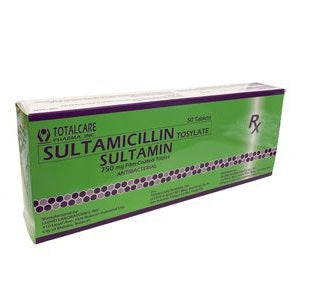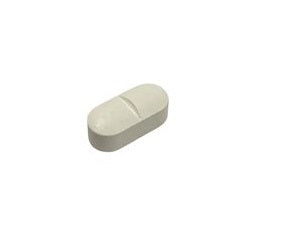Sultamin (Sultamicillin)
Sultamin (Sultamicillin)
Couldn't load pickup availability
Action
Sultamicillin is a codrug or (mutual prodrug) of ampicillin and sulbactam. After oral intake, it is absorbed and hydrolytically cleaved to ampicillin and sulbactam by enzymes in the gut wall. These two substances are then released into the system in a 1:1 molar ratio. Their pharmacokinetic behaviour is similar (and practically independent of food intake): they reach peak concentrations after about one hour; their plasma protein binding is 26% (ampicillin) and 29% (sulbactam); and their elimination half-lives are 45–80 minutes and 40–70 minutes, respectively. Both drugs are mainly eliminated via the kidneys: within eight hours after intake, 46 to 80% of the ampicillin and 41 to 66% of the sulbactam are found in the urine. Ampicillin, a semi-synthetic orally active broad-spectrum penicillin antibiotic, exerts antibacterial activity against sensitive organisms by inhibiting biosynthesis of cell wall mucopeptide. Sulbactam, a beta-lactamase inhibitor, irreversibly inhibits many beta-lactamases that occur in resistant bacteria strains.
Indication
Sultamicillin is an oral form of the penicillin antibiotic combination ampicillin/sulbactam. It is used for the treatment of bacterial infections of the upper and lower respiratory tract, the kidneys and urinary tract, skin and soft tissues, among other organs.
Contraindication
Sultamicillin is contraindicated in people with penicillin allergy and those with mononucleosis, as these have an increased risk of developing severe rashes.
Adverse Reaction
The most common side effect, as with many other antibiotics, is diarrhoea and soft stool. In Japanese clinical trials, these occurred with a frequency of 3.7% and 1.1%, respectively; however, in studies outside Japan, diarrhoea was much more common at 10% to over 50% in patients taking sultamicillin. Other adverse effects occurring in the range of 1 to 10% of people include nausea, vomiting, stomach ache, headache, rashes, and infections with Candida albicans. Haemorrhagic colitis caused by Clostridium difficile infections is a rare complication.
Interaction
Interactions with other drugs are similar to other penicillins: allopurinol increases the risk for patients to develop rashes. Penicillins slow down the elimination of methotrexate, potentially increasing its adverse effects. Conversely, the elimination of sultamicillin's active constituents (ampicillin and sulbactam) is reduced by probenecid and probably by the nonsteroidal anti-inflammatory drugs (NSAIDs) aspirin, indometacin and phenylbutazone.
Content
Content
Share





